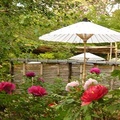Part 1 >>
Here’s another story from the past…In 1959, I visited my mother’s family home for the first time. It was a farm outside of Londrina in the state of Parana. I experienced many things for the first time there.
One was having to take off my shoes when entering the house. We had to do that at my house too, but we had a geta-bako [a place for storing shoes]. (Of course, I’d never worn geta – traditional wooden sandals). But at my grandma’s home, we would just put our shoes on the floor by the door. When I first saw shoes and sandals scattered all over the floor, I was surprised. One of my cousins let me borrow some flip-flops.
After going outside and coming back in, the flip-flops I had borrowed were gone. After looking everywhere, I heard someone say, “No one has their own flip-flops. Everybody just uses whatever sandals are around.”
That certainly wasn’t surprising. Grandma had a big family. In grandchildren alone, there were 7 kids.
That was also the first time I took a Japanese-style bath. It was a huge event, and I even wrote a poem about it called “My First Ofuro (Japanese Bath)”. (Part 3 in this series).
Hot water was overflowing from a drum can I’d never seen before. Completely clueless, I figured it was just like taking a shower, and without rinsing off any soap I got in the bath…Everyone had this dumbfounded look on their face. I was shocked. It actually traumatized me. Since then, I’ve never once been in a Japanese-style bath.
In addition to the bath, I had another big discovery at my grandma’s house. That was the reception room, which had a wealthier feel than the other rooms.
For a rural home of the time, it was well furnished and coordinated, and if you looked up at the wooden walls, there was a photograph in a frame. I instantly knew it was a picture of the Emperor and Empress. Why? Because that same year in April there was a wedding for the Crown Prince and we saw photos of the Emperor and his family in the Brazilian newspapers and magazines.
My grandma took pride in the Emperor. She would cut out pictures from Japanese magazines and carefully put them in a cardboard frame she made my hand.
Like the picture of the Holy Family that decorated the homes of a typical Brazilian family, these photographs of the Emperor and his family were precious. To my grandparents, the Emperor was a god.
There’s no question that the prime example of “old-time Japan” is found in the way the Japanese language is used.
The boom of Brazilians emigrating to Japan began in the 1980s. It was a big chance for Japanese-Brazilians. Even if they couldn’t really speak Japanese, they’d casually think “We’ll get by” and leave Brazil, carrying with them their dreams and aspirations. However, the language barrier was too high. Japanese-Brazilians didn’t know they also had to contend with foreign words incorporated into Japanese, slang, and even the differences in the language between men and women. Some sad episodes arose from that.
But like magic, there was one word that could make everyone laugh. That was “benjo”. Among Japanese-Brazilians, “benjo” and the emigration boom are tied together. It makes for some interesting stories.
There’s also a funny story about Japanese bidets.
3 sisters from a rural part of Brazil’s Minas Gerais went to Japan. When a bus they were on stopped at the service area, the sisters headed for the bathroom. The younger sister went first and tried to use the bidet. Since she couldn’t read the instructions, she just pushed the button closest to her. Like a shower, water shot up from below and the younger sister let out a scream. The older sisters, truly worried, rushed to save her. The screams of the younger sister could be heard far away. The two older siblings called out for help. The people around didn’t know what was going on. Finally, the younger sister emerged, her face pale. The three sisters hugged each other, crying loudly. The people nearby became more and more confused. For those three sisters, it was certainly a moment they won’t forget.
The lives of we Japanese-Brazilians are certainly amusing.
Old-time Japan…It’s right here in Brazil!
© 2011 Laura Honda-Hasegawa




